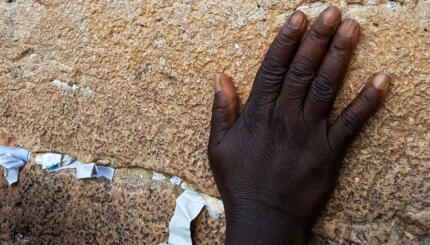For videos on Jewish weddings, scroll to the bottom of this article.
As interfaith weddings are becoming more common, cultural differences can add more stress to the occasion, especially if couples seek to honor both religious traditions. In fact, how to make wedding ceremonies inclusive and comfortable for the families, friends and guests is one of the most frequently-asked questions InterfaithFamily receives. More tips and sample prayers can be found in the group’s Guide to Wedding Ceremonies for Interfaith Families.
Are you planning a Jewish wedding? Let us help out! Sign up for Breaking the Glass, an email series that will help guide you to the wedding that’s right for you!
1. Involve
Involve family and friends in the planning.They will be more connected to the wedding if they have been a part of making the day a special one.
2. Explain
Provide a program with definitions and explanations of the various traditions and rituals represented in the ceremony, and ask the officiant to explain them during the ceremony.
3. Acknowledge
Acknowledge the couple’s two faith backgrounds at various points during the ceremony.
4. Be Sensitive
Choose readings that either are common to both traditions, or do not offend either one. Many wonderful readings used by interfaith couples do not come from any religious tradition, while other readings and prayers that do come from one religious tradition are not inconsistent or off-putting to participants from another faith. Consult with clergy over any questions or concerns you may have.
5. Common Rituals
Similarly, include rituals that are common to both traditions, or do not offend either one, for example blessings over wine, or lighting a Unity Candle, a traditional part of a Christian wedding.
6. Customize Your Ketubah
Create an interfaith ketubah, the Jewish marriage contract, now often a work of art couples frame and display in their homes.
7. Bring Both Families Under the Chuppah
Involve both families and traditions with the chuppah, the Jewish wedding canopy, representing the home that the couple will build together, that often consists of four poles and a cloth covering. Have the parents who are not Jewish make the chuppah covering. Have members of both families decorate and/or hold the chuppah poles. Have the chuppah covering reflect the tradition of the family that is not Jewish. One couple with a Chinese background had guests sign a red silk piece of material that was then used for the chuppah covering. (In Chinese culture red symbolizes joy and features prominently in wedding clothing and ritual objects).
8. Make the Sheva Brachot Participatory
Choose seven friends and family members from both sides to offer either the original or alternative versions of the sheva b’rachot, the seven blessings traditionally recited during a Jewish wedding.
9. Translate the Hebrew
Be sure that anything said in Hebrew — and any other language incorporated into the ceremony — is translated so that everyone present can understand.
10. Other Inclusive Activities
Include inclusive activities such as the handshake of peace, passing around a challah, or joining hands to sing a song together or to wish the couple well.
Seeking an officiant for a wedding? Fill out this quick form to be connected with a clergy person.
Reprinted with permission from InterfaithFamily: supporting interfaith families exploring Jewish life. Sign up for their newsletters here.
chuppah
Pronounced: KHOOP-uh or khoo-PAH, Origin: Hebrew, canopy under which a Jewish wedding ceremony takes place.



